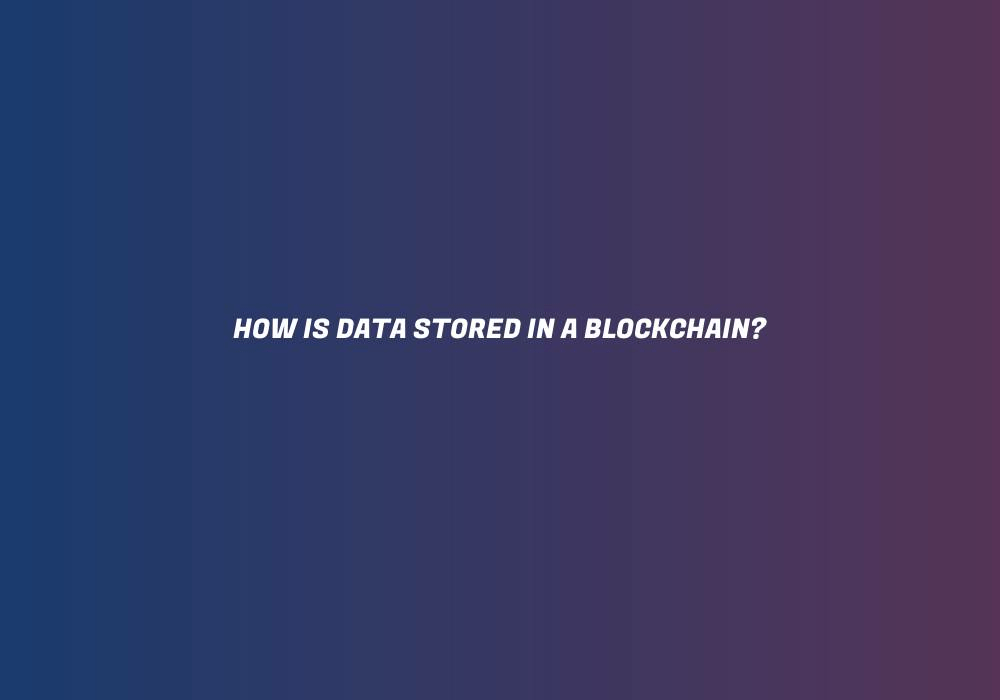Did you ever wonder how data is stored in a blockchain? It’s a fascinating concept that relies on a decentralized network of computers, known as nodes, to maintain and secure the data. Each block in the blockchain contains a unique identifier, a timestamp, and the data itself. Through a process called hashing, the data is converted into a fixed-length string of characters, ensuring its integrity and preventing tampering. These blocks are then linked together using cryptographic hashes, creating a chain of information that is virtually unalterable. It’s a remarkable technology that has revolutionized industries and opened up new possibilities for storing and securing data.
Overview of Blockchain Technology
Definition of blockchain
Blockchain is a revolutionary technology that provides a secure and decentralized method of storing and managing digital information. It is a distributed ledger that records and stores data across multiple computers, ensuring transparency, immutability, and security. In simple terms, a blockchain can be described as a chain of blocks that contain information, connected through cryptographic links.
Basic components of a blockchain
A blockchain consists of three basic components: blocks, transactions, and hash functions. A block is a collection of transactions that are bundled together and added to the blockchain. Each transaction represents a specific action or data entry. Hash functions ensure the security and integrity of the data by creating a unique digital fingerprint, known as a hash, for each block.
How blockchain works
Blockchain technology operates on a peer-to-peer network, allowing participants to share and access the data without the need for a central authority. When a transaction is initiated, it is broadcasted to the network, where it is validated by multiple participants, also known as miners. Once the transaction is verified, it is added to a block along with other validated transactions. The block is then added to the existing chain of blocks, forming the blockchain. This decentralized and transparent process ensures the security and reliability of the stored data.
Data Structure in Blockchain
Blocks in a blockchain
Blocks are a fundamental unit of storage in a blockchain. They contain a set of transactions that are grouped together and added to the chain. Each block has a unique identifier, known as a block header, which includes crucial information such as the previous block’s hash, a timestamp, and a nonce. The block header, along with the transactions, form the content of a block.
Transactions within blocks
Transactions represent the actions performed in a blockchain system. They can include various types of data, ranging from financial transactions to the storage of digital assets or any form of information. Each transaction is digitally signed by the sender to ensure the authenticity and integrity of the data. Once a transaction is included in a block, it becomes part of the blockchain and cannot be altered or removed.
Hash functions in blockchain
Hash functions play a vital role in the security and efficiency of blockchain technology. They convert arbitrary data into a fixed-size string, known as a hash, which uniquely represents the input data. Hash functions are cryptographic algorithms that are designed to be irreversible, meaning it is extremely difficult to derive the original data from its hash. This property ensures the immutability and integrity of the blockchain, as any modification in the data would result in a different hash value.
Merkle trees for secure storage
Merkle trees are a data structure used in blockchain technology to provide secure and efficient storage of data. They are binary trees constructed using hash functions, where each leaf node represents a transaction and each non-leaf node represents the hash of its child nodes. The root of the Merkle tree is also known as the Merkle root and is included in the block header. This data structure allows for efficient verification of the integrity of the data and quick identification of any changes or tampering in the blockchain.

Decentralized Storage in Blockchain
Peer-to-peer network
Decentralized storage in blockchain relies on a peer-to-peer network, where participants share and store the blockchain data across multiple computers or nodes. Each node maintains a copy of the entire blockchain, ensuring redundancy and fault tolerance. This peer-to-peer network removes the need for a central authority or single point of failure, making the storage and retrieval of data more resilient and secure.
Distributed ledger
The distributed ledger is a key aspect of decentralized storage in blockchain. It is a database that consists of all the transactions and blocks that have been added to the blockchain. Every participant in the blockchain network has a full copy of the distributed ledger, ensuring transparency and enabling any participant to verify the integrity of the stored data. The distributed nature of the ledger ensures that no single entity has complete control over the data, promoting trust and decentralization.
Consensus algorithm
In a decentralized storage system, consensus algorithms are used to achieve agreement among the participants on the order and validity of transactions. These algorithms ensure that all participants in the network agree on the state of the blockchain, even in the presence of malicious or faulty nodes. Popular consensus algorithms used in blockchain technology include Proof of Work (PoW) and Proof of Stake (PoS), each with its own strengths and trade-offs.
Immutable Storage
Immutable nature of blockchain
One of the key features of blockchain technology is its immutability. Once data is added to a block and added to the blockchain, it becomes virtually impossible to alter or delete it. This immutability is achieved through the use of cryptographic hash functions and the distributed nature of the blockchain network. Any attempt to modify the data in a block would require changing the hash of that block and all subsequent blocks, which is computationally infeasible and would be detected by other nodes in the network.
Digital signatures for data integrity
Digital signatures are an essential component in ensuring the integrity and authenticity of data stored in a blockchain. Each transaction is digitally signed using the sender’s private key, creating a unique signature that verifies the origin and integrity of the data. These signatures provide cryptographic proof that the transaction has not been tampered with and can be verified by other participants in the network. By using digital signatures, the blockchain system ensures that only authorized participants can initiate and authenticate transactions.
Transaction Confirmation and Validation
Role of miners
Miners play a crucial role in the confirmation and validation of transactions in a blockchain system. They are responsible for processing and verifying the validity of each transaction before it is added to a block. Miners compete with each other to solve complex mathematical puzzles, known as proof-of-work, to secure the network and earn rewards. Once a miner successfully solves the puzzle, they broadcast the solution and the validated block to the network.
Validating and confirming transactions
To ensure the integrity and consistency of the blockchain, transactions need to be validated and confirmed by multiple participants in the network. Once a transaction is included in a block, it undergoes a validation process, where miners verify the digital signature of the transaction, the availability of sufficient funds, and adherence to any predefined rules or conditions. After successful validation, the transaction is confirmed and added to the blockchain, becoming a permanent and immutable record.
Data Encryption in Blockchain
Public-key cryptography
Public-key cryptography is a cryptographic technique widely used in blockchain technology to ensure secure data storage. It involves the use of a pair of cryptographic keys – a public key and a private key. The public key is shared freely and is used to encrypt data, while the private key is kept secret and is used for decryption. Public-key cryptography enables participants to securely exchange data without revealing their private keys, providing confidentiality and integrity to the stored data.
Address and private key
In a blockchain system, participants are identified by their unique addresses, which are derived from their public keys. These addresses serve as the destination for transactions and provide anonymity to the participants. The private key, which corresponds to the public key and address, is used to sign transactions and verify the authenticity of the data. It is essential to securely store and protect the private key to prevent unauthorized access to the participant’s data and funds.
Securely storing sensitive data
Blockchain technology offers a secure way to store sensitive data by combining encryption techniques and decentralized storage. Sensitive data can be encrypted before being added to a transaction and stored on the blockchain. By encrypting the data, only authorized participants with the corresponding decryption keys can access and decipher the information. The decentralized nature of the blockchain network provides an additional layer of security, as the data is distributed across multiple nodes, making it less vulnerable to unauthorized tampering or data breaches.

Smart Contracts and Data Storage
Introduction to smart contracts
Smart contracts are self-executing contracts with predefined terms and conditions, stored and executed on the blockchain. They are digital agreements that automatically enforce the agreed-upon rules and conditions without the need for intermediaries. By leveraging the programmability of blockchain technology, smart contracts enable the storage, management, and execution of complex business logic and can facilitate various transactions and interactions.
Storing data within smart contracts
Smart contracts can also serve as a method of data storage within the blockchain. Data can be stored directly within the smart contract code or within the blockchain itself by embedding it within a transaction. Storing data within smart contracts ensures its immutability and transparency, as the data is permanently recorded on the blockchain and can be easily accessed and verified by participants. The use of smart contracts for data storage eliminates the need for traditional centralized databases, reducing the risk of data loss or tampering.
Scalability and Performance Considerations
Blockchain size and its impact
As the blockchain grows in size with each added block, scalability becomes a crucial consideration. The larger the blockchain, the more storage and processing power is required to maintain and validate the network. The size of the blockchain impacts the time taken to synchronize new nodes, the speed of transaction processing, and the efficiency of data retrieval. Various techniques, such as compression algorithms, pruning, and archival nodes, are employed to manage the size of the blockchain and optimize its performance.
Sharding and partitioning
Sharding and partitioning are techniques used to improve the scalability of blockchain networks by dividing the workload and data across multiple nodes. Sharding involves splitting the blockchain into smaller pieces, or shards, each capable of processing a subset of transactions or storing a portion of the data. Partitioning involves organizing the data within each shard to optimize performance and accessibility. Sharding and partitioning allow for parallel processing and reduce the burden on individual nodes, enabling blockchain networks to handle increased transaction volumes and improve overall performance.
Consensus algorithm efficiency
The choice of consensus algorithm has a significant impact on the scalability and performance of a blockchain network. Different consensus algorithms have varying levels of efficiency and resource requirements. Proof-of-Work (PoW) algorithms, such as the one used by Bitcoin, require extensive computational power and energy consumption, which can limit scalability. On the other hand, consensus algorithms like Proof-of-Stake (PoS) and Delegated Proof-of-Stake (DPoS) aim to increase scalability by reducing the computational requirements while still maintaining the security and integrity of the network.
Interoperability and Data Storage
Different blockchain protocols
Blockchain technology has evolved with the introduction of various protocols, each designed to address specific needs and requirements. Different blockchain protocols, such as Bitcoin, Ethereum, and Hyperledger, have their own rules, transaction models, and storage mechanisms. Interoperability refers to the ability of different blockchain protocols to communicate and interact seamlessly. Efforts are being made to develop standards and protocols, such as cross-chain communication protocols, to enable interoperability and facilitate the exchange and transfer of data between different blockchains.
Cross-chain communication
Cross-chain communication enables the transfer of data and information between different blockchain networks. It allows for interoperability and facilitates the exchange of assets, tokens, or data across various blockchains. Cross-chain communication protocols, such as atomic swaps and relay chains, ensure secure and trustless transactions between different blockchains without the need for intermediaries. This interoperability extends the functionality and utility of blockchain networks, enabling them to interact with other blockchain ecosystems and access a broader range of data and services.
Data synchronization between blockchains
Data synchronization is a crucial aspect of interoperability between different blockchain networks. It ensures that the data across multiple blockchains is consistent and up to date. Data synchronization mechanisms can include cross-chain validators, data bridges, or relayers that facilitate the transfer and verification of data between blockchains. By synchronizing data between different blockchains, participants can access and utilize data from different sources, enhancing the overall functionality and value of the blockchain ecosystem.
Privacy and Data Protection
Pseudonymity and privacy in blockchain
Blockchain technology offers a level of pseudonymity, where participants are identified by their unique addresses rather than their real-world identities. While this provides some privacy, it is important to note that blockchain transactions are transparent and can be traced to their origin. Therefore, the privacy of participants depends on the extent to which their real-world identity can be linked to their blockchain address. To enhance privacy, techniques such as coin mixing, ring signatures, and zero-knowledge proofs are being developed to obfuscate transaction details and provide stronger privacy protections.
Zero-knowledge proofs
Zero-knowledge proofs are cryptographic techniques used to validate the truthfulness of a statement without revealing the specific information underlying that statement. In the context of blockchain, zero-knowledge proofs enable participants to prove the validity of a transaction or claim without disclosing the details or content of the transaction. By utilizing zero-knowledge proofs, blockchain networks can provide stronger privacy guarantees while still ensuring the integrity and verifiability of the data.
Permissioned blockchains for sensitive data
In scenarios where privacy and data protection are paramount, permissioned blockchains are often used. Permissioned blockchains restrict participation and access to a predefined set of trusted entities, ensuring that sensitive data is kept within a controlled and secure environment. These blockchains usually require participants to be authenticated and authorized, providing an additional layer of privacy and security. Permissioned blockchains are commonly adopted by enterprises and organizations that handle sensitive data, such as financial institutions or healthcare providers, where regulatory compliance and privacy regulations are essential considerations.
In conclusion, blockchain technology provides a robust and secure method of storing and managing data. By leveraging distributed ledger technology, cryptographic techniques, and decentralized storage, blockchain ensures transparency, immutability, and privacy. With further advancements in scalability, interoperability, and privacy-enhancing techniques, blockchain technology will continue to evolve, ushering in new possibilities for data storage and revolutionizing various industries.
